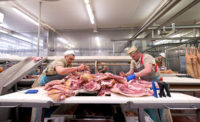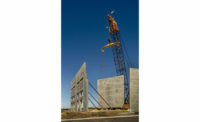Few things are as American as the Wild West, cowboys and wrangling steer. Cattle don’t travel by foot across several states to their final destination anymore; however, there is still a need for cattle drivers – just not always of the human variety.
And that’s proving to be a good thing. Last fall, robotic cattle drivers were born out of a partnership with Cargill and Colorado State University’s Temple Grandin, professor of animal science. This new breed of cattle driver moves cattle off the unloading ramp to holding pens and the stunning area at processing plants through automated arms, blowers and audio recordings. Employees actually operate them from a catwalk above the holding pen, so they don’t interact with and upset the cattle and improve their own workplace safety. Another bonus? The drivers can operate in rain, snow or mud with no delays to the operation.
“At Cargill, the safety of our people and the animals in our care is our No. 1 priority,” says Brad Churchill, plant operations manager at Cargill Protein North America, based in Wichita, Kan. Churchill envisioned and brought the robot to fruition. “When a vendor showed me a video of an early version robot, I knew within 10 seconds of watching that we could potentially move cattle with that kind of robot, and that it could make our teammates’ jobs safer.”
That robot was initially meant for other purposes, so over two years the team had to make several modifications to the robot to work in an environment with live animals. “But after several prototypes, we built one that is very effective at safely and humanely moving cattle,” Churchill says.
The cattle drivers will be used at Cargill Protein beef plants in the U.S. and Canada.
“So far, we have been really pleased with the results,” Churchill says. “Due to the success of our initial pilot program, we are in the process of rolling out the robots at several of our Cargill beef facilities. We have also heard from others in the industry that they would like to explore a similar solution.”
According to Churchill, employee feedback has also been positive. “When we tested it out in one of our plants, I had planned to be there for three days,” he says. “After 45 minutes, I could have gone home. We already had employees operating the robot and using the robot to move cattle via a remote controller from a catwalk overlooking the pen.”
Cargill’s robot initiative was also aided by animal welfare experts, beef plant employees and engineers from equipment supplier and manufacturer Flock Free.
“I think Cargill’s development of this cattle-handling robot was a very creative and innovative project,” says Lily Edwards-Callaway, assistant professor of animal sciences at Colorado State University, based in Fort Collins, Colo. “Effective human-animal interaction is crucial for both human and animal safety, and I think Cargill was able to promote both of these with the robot. I look forward to seeing more innovations like this in the future.”
Overseeing poultry houses
The poultry industry is developing its own helpers. Georgia Tech Research Institute’s (GTRI) Gohbot is a poultry-house robot that uses imaging sensors to detect and pick up floor eggs and dead chickens from poultry houses.
“The most significant challenge for us is to keep the cost of the system down so as to make it an attractive system for farmers,” says Colin Usher, research scientist, GTRI, based in Atlanta. “If the technology is cost prohibitive, it will not matter how good it works since no farmer would consider buying one.”
Gohbot can work 24/7 to evaluate the flock status, remove eggs and assess mortality. Artificial intelligence routines and 2D and 3D sensors working with infrastructure help it move around commercial chicken houses.
Its testing process concluded in a test broiler flock with birds from day one through six weeks, to represent a regular grow-out duration. “During this time, we found challenges with the robot operating on the first two days due to the small size of the birds and the fact that they spent most of this time laying down and sleeping,” Usher says.
It seems chickens accepted their house robot after three days, because from day three through the next 39 days, the robot interacted with the chickens, navigated the room and operated without problems.
“In all, the robot was run an average of three hours a day [fully autonomously], every day for the six weeks,” Usher says. “During this time, the birds became acclimated to the robot and in the final week, they became very sedentary. Even with these ‘issues,’ the robot was still able to successfully navigate the space with the nudging interactions specifically designed to encourage the birds to move.”
After this trial, the GTRI team has upgraded Gohbot’s hardware as newer, more powerful sensors come out. “We also integrated a robot arm capable of picking floor eggs in a broiler-breeder facility,” says Usher. “We tested and demonstrated the system picking eggs autonomously in a test broiler-breeder house.”
The next phase of work is focused on detection and removal of mortality in the house. “We will be testing and demonstrating all of the robot capabilities in commercial broiler and broiler-breeder houses over the course of the next year,” Usher says.
Last year’s Poultry Tech Summit also featured ChickenBoy, which monitors the chicken house for health issues, areas of dead birds, bedding problems and ambient conditions, the U.S. Department of Agriculture’s Agriculture Research Service’s (ARS’) machine vision system for detecting woody breast in boneless skinless breast filets and GTRI’s virtual reality system for simulating cutting trajectories for automated poultry processing systems.
Pairing machines with AI
“In general, robots are good at doing the same thing over and over, and not getting tired — or bored,” says Bruce Ackman, industry and energy commercial lead at Cambridge Consultants, based in Providence, R.I. “But they are not good at problem solving. So, if a box gets crushed, they can’t deal with that without human intervention.”
Robots need their machine vision to be paired with artificial intelligence, so they can make decisions, he says.
Recent developments are embedded custom-made sensors into silicon fingers. “The touch sensors provide feedback to help the robot become ‘smart,’” Ackman says. “They tell the system if it has a good grasp or the object is slipping.”
While the technology is not fine-tuned yet and its cost may be too high, the alternative to automation and robotics is companies spending an unsustainable amount of money on employee turnover and training. The need for labor provides the incentive for automation of unpleasant jobs (specifically, the tedious, obnoxious parts), but worker acceptance remains an issue.
“We’re at an inflection point as labor issues put increased pressure on companies,” says Ackman. “People don’t want to do these jobs anymore. No one is trying to get rid of workers, but retaining them is becoming too hard.”
Instead, robots’ tools — cameras, computers, artificial intelligence and fingertips — can supplement the workers’ daily routine.
“They won’t make the job faster, but will help workers do their jobs better,” Ackman says. “And their jobs will be more pleasant and palatable.” NP




